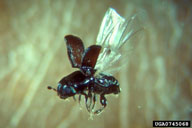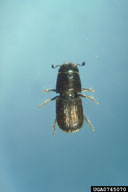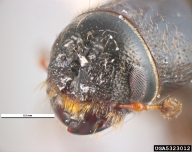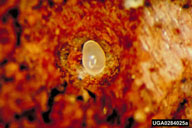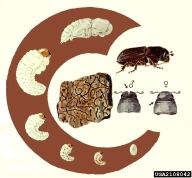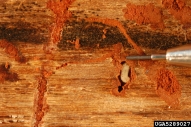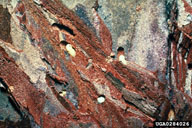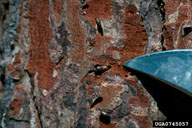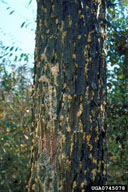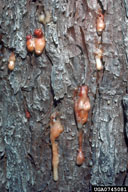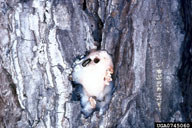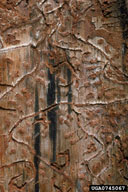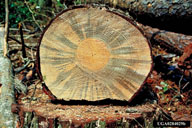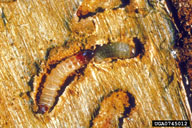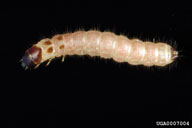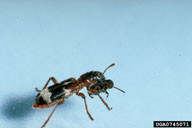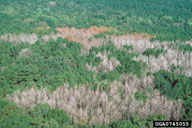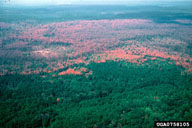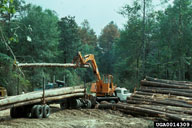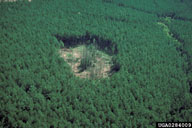Southern pine beetle
Dendroctonus frontalis (Zimmermann), (Coleoptera: Curculionidae, Scolytinae)
Orientation to pest
Southern pine beetle, Dendroctonus frontalis (Zimmermann), is the most destructive bark beetle attacking pines in the southern United States. It is a native North American species that also occurs in Mexico and Central America. Its principal hosts are yellow pines, especially shortleaf (Pinus echinata Mill.), loblolly (Pinus taeda L.), Virginia (Pinus virginiana Mill.), and pitch (Pinus rigida Mill.) pines. Beetles overwinter in all stages and timing of adult emergence in spring varies with location, from mid-March to June. Bark areas from which adults have emerged have a shot-hole-like appearance. Attack by adults during warm days in winter is usually on previously attacked trees and is focused initially on the mid to upper part of the tree. Females construct a nuptial chamber, where they are later joined by males. An S-shaped oviposition gallery is then constructed, along which eggs are laid. Larval galleries are at right angles to the oviposition gallery and score the wood. Larval tunnels are primarily in the bark and pupation occurs at the end of the larval gallery. With each new generation, infested areas expand, sometimes covering very large areas. In western North Carolina there are three to five generations per year and up to seven per year further south. The generations overlap, so in active infestations, all life stages of the beetle are present at any one time and adult beetles emerge and attack new trees daily when temperatures allow. Trees under 15 years of age or 5 cm in diameter are rarely attacked. Infestations typically begin in stands of trees stressed by high tree density, logging damage, lightning, dryness, flooding, or disease. Trees die either because they are girdled by larval galleries, or because of the effects of a blue stain fungus (Ceratocystis minor [Hedgc.] Hunt), which is vectored by the beetle. Damage from outbreaks is reduced somewhat by managing stands to reduce tree stress and by halting the expansion of initial spots using salvage (cut-and-remove) or cut-and-leave control methods.
Hosts commonly attacked
Principal species in which reproduction of southern pine beetle occurs are the yellow pines, especially shortleaf (P. echinata), loblolly (P. taeda), Virginia (P. virginiana), and pitch (P. rigida) pines. The beetle also attacks species such as longleaf (Pinus palustris Miller) and slash (Pinus elliottii Engelm.) pines, but reproduction is often less successful due to heavy resin flow.
Distribution
This bark beetle is found throughout the southeastern and southern parts of the United States, as well as Mexico and parts of Central America.
 Eastern Forest Environmental Threat Assessment Center • Threat Summary Eastern Forest Environmental Threat Assessment Center • Threat Summary |
| Figure 1. Distribution of southern pine beetle |
Images of southern pine beetle
| Figure 2. Adults of southern pine beetle; left, beetle in flight | Figure 3. The head of the southern pine beetle is diagnostic for the species. The head is broad, with a distinct notch or frontal groove on male beetles, bordered by distinct projections or tubercules on either side of the groove. The antennae are seven-segmented, consisting of the basal pedicel, elongated scape, four-segmented funicle, and an enlarged club. |
| Figure 4. Egg of southern pine beetle | Figure 5. Life cycle diagram of southern pine beetle (left), showing various larval stages; view of southern pine beetle larva in wood (right) | Figure 6. Pupae of southern pine beetle | |
| Figure 7. Young adults of southern pine beetle in galleries, ready to emerge | Figure 8. Pitch tubes on pines (left) are a sign of bark beetles such as southern pine beetle; close up of pitch tube (middle), and female southern pine beetle with entrance hole in pitch tube (right) | ||
| Figure 9. Galleries of southern pine beetle and associated blue stain (left), and view of blue stain fungus (right) in cross section slice of trunk | |
| Figure 10. Initial point of outbreak ("spot") of southern pine beetle (left) and larger area of damage, to loblolly pine (right) | |
| Figure 11. Tree felling is a control method (left) used to prevent expansion of spot infestations (right, spot after infested trees have been removed). Infested trees and uninfested trees in a buffer zone are either cut and removed or cut and left in place, in either case for the purpose of stopping spot expansion. | Figure 12. Larva of checkered beetle, Thanasimus dubius (Fabricius) (Cleridae) eating a southern pine beetle larva (top) and close up of T. dubius larva (middle); adult of T. dubius with prey (bottom) |
Important biological control agents related to this pest species
The most important natural enemies of southern pine beetles are predacious clerid beetles. These predators are attracted to the aggregation pheromone and host volatiles used in traps to assess southern pine beetle densities in particular stands. Comparison of pest and predator numbers caught in traps is used each spring throughout the southern and eastern United States to forecast southern pine beetle population trends (outbreaks or population declines) (Fig. 13).
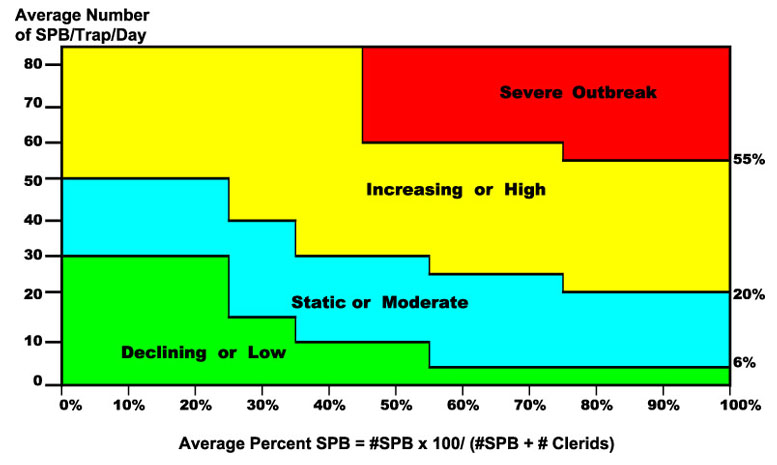 Developed by Ron Billings, Texas Forest Service. (see Billings and Upton, 2010) Developed by Ron Billings, Texas Forest Service. (see Billings and Upton, 2010) |
| Figure 13. A decision chart to forecast southern pine beetle outbreaks, using information on density of the bark beetle and its clerid predator in traps baited with aggregation pheromone |
Web links for information on southern pine beetle
- Species Profile | United Nations, Food and Agriculture Organization
PDF from the global review of forest pests and disease - Featured Creature Fact Sheet | University of Florida and FDACS
- Technical Bulletin on BarkBeetles.org | Expanded Southern Pine Beetle Research and Applications Program, USDA Forest Service
- Publication on BarkBeetles.org | Texas Forest Service and Honduran Forestry Development Corporation
How to recognize, prevent and control outbreaks in Central America
Articles
- Chellman, C. W. and R. C. Wilkinson. 1975. Recent history of southern pine beetle, Dendroctonus frontalis Zimm. (Col.; Scolytidae), in Florida. Florida Entomologist 58: 22.
- Dixon, W. N. and T. L. Payne. 1979. Aggregation of Thanasimus dubius on trees under mass-attack by the southern pine beetle. Environmental Entomology 8: 178-181.
- Billings, R. F. and H. A. Pase III. 1979. A field guide for ground checking southern pine beetle spots. U.S. Department of Agriculture, Combined Forest Pest Research and Development Program, Agriculture Handbook No. 558. 19 pp.
- Swain, K. M. and M. C. Remion. 1981. Direct control methods for the southern pine beetle. U.S. Department of Agriculture, Combined Forest Pest Research and Development Program, Agriculture Handbook No. 575. 15 pp.
- Billings, R.F. and W. W. Upton. 1993. Effectiveness of synthetic behavioral chemicals for manipulation and control of southern pine beetle infestations in East Texas. USDA Forest Service, Southern Forest Experiment Station. General Technical Report, pp. 555-568.
- Clarke, S. L. and J. T. Nowak. 2009. Southern pine beetle. Forest Insect and Disease Leaflet No. 49, USDA Forest Service, Portland, Oregon, United States. 8pp.
- Billings, R. F. and W. W. Upton. 2010. A methodology for assessing annual risk of southern pine beetle outbreaks across the Southern Region, using pheromone traps, pp. 73-85. In: Pye, J. M., H. M. Rauscher, Y. Sands, D. C. Lee, J. S. Beatty (tech. eds.) 2010. Advances in threat assessment and their application to forest and rangeland management. General Technical Report PNW-GTR-802. U.S. Department of Agriculture, Forest Service, Pacific Northwest and Southern Research Stations, Portland, Oregon, United States. 708 pp., 2 vol.) (image available at http://www.threats.forestencyclopedia.net/p/p3291)
